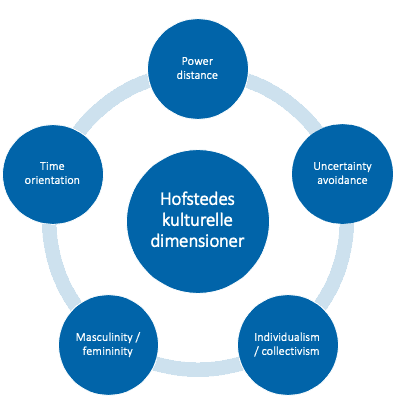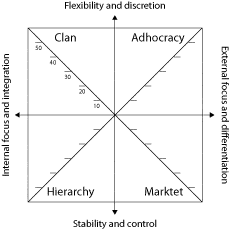"Culture eats strategy for breakfast" (Peter Drucker). When faced with developing or implementing an organization's strategy, its culture is both an abstract and a very important area of focus. The question that arises is whether you can even measure something so intangible and develop an organization's culture in a direction that matches the strategy. Pssst...spoiler alert: Yes, you can - read on!
What is the purpose of a cultural analysis?
Many consultants and leaders will recognize the challenges of communicating a common direction, formulating sub-strategies and creating the necessary cultural changes required. According to John Kotter, we need to look at culture in relation to strategy and successful change, but few people have concrete ways to spot and influence culture. If you've gotten to the point where you're looking at organizational culture in relation to the implementation of your strategy, you're well on your way! Around 70% of all change initiatives fail (McKinsey 2012; Kotter 1995), with the vast majority of them related to organizational culture (Cabrera et al. 2001; Nassira 2011).
An organization's culture determines natural behavior - what we perceive as normal - and can be influenced by a leader's systematic and conscious behavior. But how do you gain insight into whether your culture is a partner or opponent in the organization's strategy and what behavior is needed to
What is organizational culture?
Culture is, among other things, an expression of behavior, habits, manners, attitudes and traditions and thus also an expression of the way we as humans do things. In an organization, organizational culture is what binds the people, processes, systems and structures within the organization together.
What is a cultural analysis and how do you do it?
An organization's culture determines natural behavior - what we perceive as normal - and can be influenced by a leader's systematic and conscious behavior. But how do you gain insight into whether your culture is a partner or opponent in your organization's strategy and what behavior is required? With a culture analysis! Below, we'll go through the generic and tailored cultural analysis and then look at how to successfully translate strategy into action in relation to organizational culture.
The generic culture analysis
There are many approaches to understanding organizational cultures, including Schein's iceberg metaphor, which consists of the visible artifacts and the more invisible values and basic assumptions. Hofstede 's cultural dimensions can also be used to understand how to assess whether a culture leans more towards one pole or the other.

A more concrete approach can be found in the Organizational Culture Assessment Instrument (OCAI), which is based on the theory of Cameron and Quinn. The basic idea is that if there is a mismatch between the organizational culture and the company's strategic intentions, then the culture must be changed to align with the strategies.

Organizations are also characterized by interdisciplinary collaborative interfaces, which can capture how cultural factors such as problem-solving communication determine how strong a degree of relational coordination(Jody Gittel) can be cultivated within and across departments.

The tailored culture analysis
Another method is a tailored measurement to get a tangible picture of where you need to take action to succeed with a new strategy or to support the ongoing implementation of the strategy.
Measurements can be tailored to measure the elements you want to promote as a leader, as per the well-known phrase 'You get what you measure'. For example, leadership evaluation can provide a common picture of where organizations can develop cohesive efforts, e.g. whether leaders are supporting the strategic direction and shaping the culture at a higher level as well as in practice.
Some concrete cases of this are:
The large Danish design company, who wanted to know if their managers supported the creative processes so that both new products were created and old ideas were implemented. A key learning here was that employees did not experience the right guidance from management so that ideas were actually prioritized and structured.
The municipality that annually sets three concrete strategic focus areas. They wanted to ensure that managers supported these strategic directions. It was believed that what was taken for granted in the culture and had already been implemented long ago was not what employees were experiencing from their managers.
Want to be even better equipped to work with cultural analysis?
LEAD's implementation training gives you the methods to design, facilitate and lead strategic implementation processes and changes to create the impact you need.
This is an education for those who work with development, processes and change management.
Learn more about our research-based implementation training
How do you successfully turn strategy into action?
It quickly becomes clear that we need to evaluate to learn more about how we implement. Implementation management is all about setting a clear direction and creating good conditions for development and change in the organization.
"This requires an understanding and ongoing exploration of the particularities of the organization that influence how a strategy can be translated into action and organizational outcomes." (Conrad, 2015).
Use culture analysis to execute a successful implementation
It quickly becomes clear that we need to evaluate to learn more about how we implement. Implementation management is all about setting a clear direction and creating good conditions for development and change in the organization.
"This requires an understanding and ongoing exploration of the particularities of the organization that influence how a strategy can be translated into action and organizational outcomes." (Conrad, 2015).
Use culture analysis to execute a successful implementation
Two concrete cases in point are:
Folkeskolen, which wanted to be the frontrunner with a strategy to become a profile school for creativity, innovation and entrepreneurship. A lot of initiatives were put in place to strengthen creativity and innovation, which had a positive effect on various core results, such as an increase in student engagement.
The next natural step was to look at what the school's creative climate looked like among both employees and managers to ensure that supportive behavior continued. Through surveys, as per the research, it became clear that they were on the right track, but that there were still key elements to be aware of as the strategy progressed.
The region, that would strengthen the power of implementation. They knew that they were good at launching a lot of good and useful initiatives. However, they still found themselves in a place where many new ships were being launched - and very few of them were being brought safely into port. A key element of the strategy needed to be changed to strengthen the power of implementation, according to research and our own experience.
The status of the organization was investigated through interviews with both managers and employees. Here it became clear that some things were running really well in the culture in relation to the strategy, and others needed a new boost - and a new behavior that had to be trained.
How do we get started with a culture analysis?
The word culture comes from Latin culturawhich means "to cultivate". In other words, we can figure out what we want to cultivate in a given organization. Common to everything that has been discussed is that you need to sharpen your own strategy and become more specific about what to look for in your own culture to see how you can measure and work on this.

Do you want to be better at:
- Plan and execute projects that don't get derailed or scrapped halfway through
- Create greater positive measurable impact from your implementations
- Create motivation, engagement and followership among your stakeholders
- Translate strategies and decisions into behavioral goals
- Work continuously on concrete behavioral and cultural changes
- Dealing with resistance from those involved
- Use learning and benefit realization as an integral part of your implementations
Then fill out the form below and receive our description of the research-based implementation training that gives you the most powerful tools for implementation in practice.




